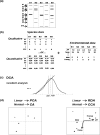Assessing the diversity of bacterial communities associated with plants
- PMID: 24031382
- PMCID: PMC3768544
- DOI: 10.1590/S1517-83822009000300001
Assessing the diversity of bacterial communities associated with plants
Abstract
Plant-bacteria interactions result from reciprocal recognition between both species. These interactions are responsible for essential biological processes in plant development and health status. Here, we present a review of the methodologies applied to investigate shifts in bacterial communities associated with plants. A description of techniques is made from initial isolations to culture-independent approaches focusing on quantitative Polymerase Chain Reaction in real time (qPCR), Denaturing Gradient Gel Electrophoresis (DGGE), clone library construction and analysis, the application of multivariate analyses to microbial ecology data and the upcoming high throughput methodologies such as microarrays and pyrosequencing. This review supplies information about the development of traditional methods and a general overview about the new insights into bacterial communities associated with plants.
Keywords: Plant–bacteria interactions; endophytes; molecular techniques; multivariate analysis; rhizosphere.
Figures


Similar articles
-
Culture-independent assessment of Rhizobiales-related alphaproteobacteria and the diversity of Methylobacterium in the rhizosphere and rhizoplane of transgenic eucalyptus.Microb Ecol. 2009 Jan;57(1):82-93. doi: 10.1007/s00248-008-9405-8. Epub 2008 Jun 7. Microb Ecol. 2009. PMID: 18536862
-
Transgenic tobacco revealing altered bacterial diversity in the rhizosphere during early plant development.Antonie Van Leeuwenhoek. 2008 May;93(4):415-24. doi: 10.1007/s10482-007-9219-6. Epub 2008 Jan 8. Antonie Van Leeuwenhoek. 2008. PMID: 18181027
-
Bulk and rhizosphere soil bacterial communities studied by denaturing gradient gel electrophoresis: plant-dependent enrichment and seasonal shifts revealed.Appl Environ Microbiol. 2001 Oct;67(10):4742-51. doi: 10.1128/AEM.67.10.4742-4751.2001. Appl Environ Microbiol. 2001. PMID: 11571180 Free PMC article.
-
[Common problems in the analyses of microbial community by denaturing gradient gel electrophoresis (DGGE)].Wei Sheng Wu Xue Bao. 2006 Apr;46(2):331-5. Wei Sheng Wu Xue Bao. 2006. PMID: 16736603 Review. Chinese.
-
[Application of denaturing gradient gel electrophoresis and temperature gradient gel electrophoresis in microbial molecular ecology].Wei Sheng Wu Xue Bao. 2004 Dec;44(6):845-8. Wei Sheng Wu Xue Bao. 2004. PMID: 16110975 Review. Chinese.
Cited by
-
The microbiome of Brazilian mangrove sediments as revealed by metagenomics.PLoS One. 2012;7(6):e38600. doi: 10.1371/journal.pone.0038600. Epub 2012 Jun 21. PLoS One. 2012. PMID: 22737213 Free PMC article.
-
Tank bromeliad water: similar or distinct environments for research of bacterial bioactives?Braz J Microbiol. 2014 May 19;45(1):185-92. doi: 10.1590/s1517-83822014000100024. eCollection 2014. Braz J Microbiol. 2014. PMID: 24948929 Free PMC article.
-
Microbial community biogeographic patterns in the rhizosphere of two Brazilian semi-arid leguminous trees.World J Microbiol Biotechnol. 2013 Jul;29(7):1233-41. doi: 10.1007/s11274-013-1286-4. Epub 2013 Feb 24. World J Microbiol Biotechnol. 2013. PMID: 23435935
-
Effectiveness of Plant Beneficial Microbes: Overview of the Methodological Approaches for the Assessment of Root Colonization and Persistence.Front Plant Sci. 2020 Jan 31;11:6. doi: 10.3389/fpls.2020.00006. eCollection 2020. Front Plant Sci. 2020. PMID: 32076431 Free PMC article. Review.
-
Different effects of transgenic maize and nontransgenic maize on nitrogen-transforming archaea and bacteria in tropical soils.Appl Environ Microbiol. 2014 Oct;80(20):6437-45. doi: 10.1128/AEM.01778-14. Epub 2014 Aug 8. Appl Environ Microbiol. 2014. PMID: 25107970 Free PMC article.
References
-
- Abby S., Daubin V. Comparative genomics and the evolution of prokaryotes. Trends Microbiol. 2007;15(3):135–141. - PubMed
-
- Adhitya A., Thomas F.I.M., Ward B.B. Diversity of assimilatory nitrate reductase genes from plankton and epiphytes associated with a seagrass bed. Microbial Ecol. 2007;54:587–597. - PubMed
-
- Ahn J.H., Kim M.C., Shin H.C., Choi M.K., Yoon S.S., Kim T., Song H.G., Lee G.H., Ka J.O. Improvement of PCR amplification bias for community structure analysis of soil bacteria by denaturing gradient gel electrophoresis. J. Microbiol. Biotechn. 2006;16(10):1561–1569.
-
- Barer M.R., Harwood C.R. Bacterial viability and culturability. Adv. Microb. Physiol. 1999;41:93–137. - PubMed
LinkOut - more resources
Full Text Sources
